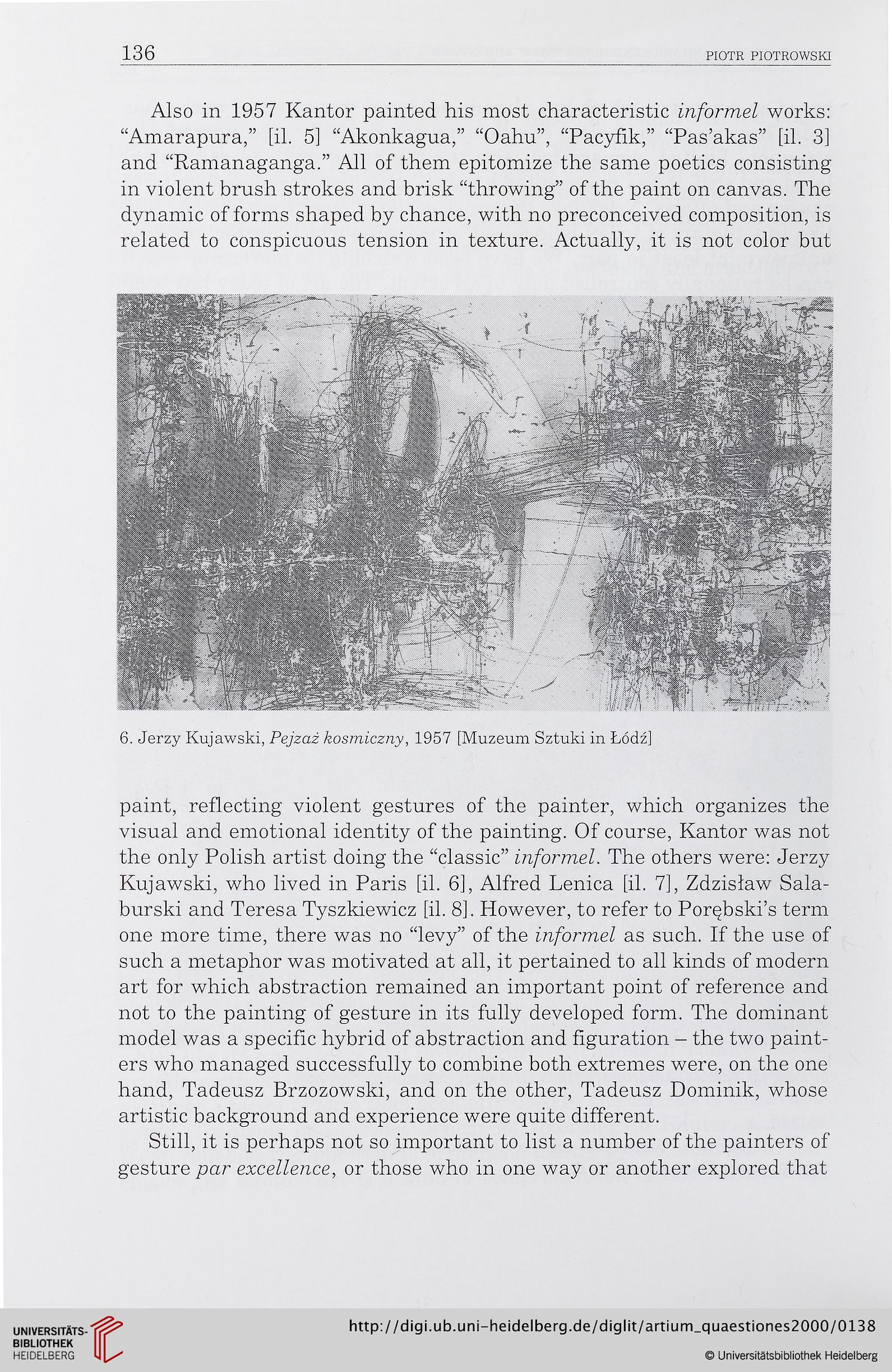136
PIOTR PIOTROWSKI
Also in 1957 Kantor painted his most characteristic informel works:
“Amarapura,” [il. 5] “Akonkagua,” “Oahu”, “Pacyfîk,” “Pas’akas” [il. 3]
and “Ramanaganga.” Ail of them epitomize the same poetics consisting
in violent brush strokes and brisk “throwing” of the paint on canvas. The
dynamic of forms shaped by chance, with no preconceived composition, is
related to conspicuous tension in texture. Actually, it is not color but
6. Jerzy Kujawski, Pejzaz kosmiczny, 1957 [Muzeum Sztuki in Lodz]
paint, reflecting violent gestures of the painter, which organizes the
visual and emotional identity of the painting. Of course, Kantor was not
the only Polish artist doing the “classic” informel. The others were: Jerzy
Kujawski, who lived in Paris [il. 6], Alfred Lenica [il. 7], Zdzisiaw Sala-
burski and Teresa Tyszkiewicz [il. 8]. However, to refer to Porçbski’s terni
one more time, there was no “levy” of the informel as such. If the use of
such a metaphor was motivated at ail, it pertained to ail kinds of modem
art for which abstraction remained an important point of reference and
not to the painting of gesture in its fully developed form. The dominant
model was a spécifie hybrid of abstraction and figuration - the two paint-
ers who managed successfully to combine both extremes were, on the one
hand, Tadeusz Brzozowski, and on the other, Tadeusz Dominik, whose
artistic background and expérience were quite different.
Still, it is perhaps not so important to list a number of the painters of
gesture par excellence, or those who in one way or another explored that
PIOTR PIOTROWSKI
Also in 1957 Kantor painted his most characteristic informel works:
“Amarapura,” [il. 5] “Akonkagua,” “Oahu”, “Pacyfîk,” “Pas’akas” [il. 3]
and “Ramanaganga.” Ail of them epitomize the same poetics consisting
in violent brush strokes and brisk “throwing” of the paint on canvas. The
dynamic of forms shaped by chance, with no preconceived composition, is
related to conspicuous tension in texture. Actually, it is not color but
6. Jerzy Kujawski, Pejzaz kosmiczny, 1957 [Muzeum Sztuki in Lodz]
paint, reflecting violent gestures of the painter, which organizes the
visual and emotional identity of the painting. Of course, Kantor was not
the only Polish artist doing the “classic” informel. The others were: Jerzy
Kujawski, who lived in Paris [il. 6], Alfred Lenica [il. 7], Zdzisiaw Sala-
burski and Teresa Tyszkiewicz [il. 8]. However, to refer to Porçbski’s terni
one more time, there was no “levy” of the informel as such. If the use of
such a metaphor was motivated at ail, it pertained to ail kinds of modem
art for which abstraction remained an important point of reference and
not to the painting of gesture in its fully developed form. The dominant
model was a spécifie hybrid of abstraction and figuration - the two paint-
ers who managed successfully to combine both extremes were, on the one
hand, Tadeusz Brzozowski, and on the other, Tadeusz Dominik, whose
artistic background and expérience were quite different.
Still, it is perhaps not so important to list a number of the painters of
gesture par excellence, or those who in one way or another explored that




